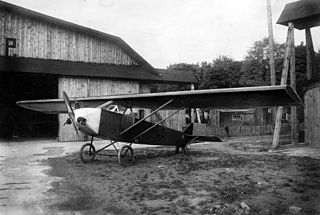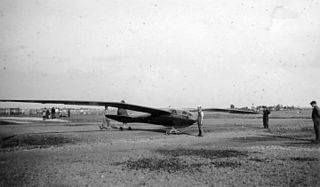Related Research Articles

The WWS-3 Delphin (Dolphin) was a single-seat glider designed and built in Poland from 1936.

The PZL Bielsko SZD-51 Junior is a Polish single-seat training and club sailplane.

The Medwecki HL 2 was a Polish two seat lightplane flown in 1927. Handicapped by a low power, unreliable engine, its flying life lasted little more than a month.

The ITS-8 was a Polish twin-boom motor glider flown in 1936. Two prototypes were completed but production was prevented by the German invasion of Poland in 1939.
The Czerwiński CW I,, was a Polish glider designed and built by a students' group. Its career was brief but it made the first generally recognized soaring flight in Poland, a strong refutation of the current idea that Polish topography was not suited to the sport.
The Czerwiński CW II,, was a Polish open frame glider. In 1929 it set a new national duration record and flew successfully until the end of 1931, when several major structural and aerodynamic modifications improved its performance. A simpler, lighter version, the CW III,, was designed and built in parallel with it and became Poland's first production glider.

The one-off, experimental Czerwiński CW IV was a Polish high performance glider and the nation's first two-seater. It set several national records and influenced later Polish designs.

The Czerwiński CW 5bis was a Polish high performance sailplane, produced and developed between 1933 and 1935. It set several national records, competed at both national and international level and remained a Polish gliding club mainstay until the outbreak of World War II.

The Czerwiński and Jaworski CWJ was a basic training glider designed and flown in Poland in 1931. Between eighty to one hundred examples of it and an improved variant, the CWJ-bis Skaut, were built.

The Blaicher B.1 was a Polish glider first flown in 1934. It was intended to fill an intermediate trainer role, but offered no advance on existing aircraft and only the prototype was completed.

The Czerwiński CW 7 was a Polish aerobatic glider first flown in 1934. Despite a structural weakness that prevented inverted flight, a small batch of CW 7s were used by several aeroclubs until the start of World War II.

The Czerwiński CW 8 was a mid-1930s Polish open-frame basic training glider. Its design was advanced and its price low, but its stalling characteristics were too dangerous for beginners, so the thirty-plus examples completed were rapidly withdrawn from use. Two were subsequently modified, one with greater span and the other with a small engine.

The ITS-IVB was a 1930s Polish two seat research sailplane designed to gather meteorological and airframe stress data. The sole example remained in service up to outbreak of World War II.

The Blaicher B-38 was a Polish, single seat sailplane completed in 1938. Notable for its use of long span Fowler flaps, its development was ended by the German invasion of Poland in September 1939.

The PWS-102 Rekin was a progressive development of the PWS-101, intended for cross-country flights. The prototype flew in an international contest in 1939 and the first of a projected production series was flown before the start of World War II.
The PWS-103 was a high performance, Polish 15 m span sailplane developed from the longer-span PWS-102 just before World War II.

The Czajka or Kocjan Czajka after its designer was a Polish secondary training glider which was in continuous production from 1931 to the start of World War II. More than 160 were completed in Warsztaty Szybowcowe in Warsaw.

The D.W.L. SG-21 Lwów was a Polish high performance sailplane built for the Polish government. Though both it and a development, the SG-28, were one-offs, they set several national records and led to the batch-produced Warsztaty Szybowcowe SG-3.

The Naleszkiewicz-Nowotny NN 2 was a Polish primary glider first flown in 1931. An improved version followed in 1932 but only three were built in total.
The PZL M-3 Pliszka (Wagtail) was the first all-metal Polish glider. Three were built but its performance, particularly its glide ratio, was not good enough for it to be produced for Polish clubs.